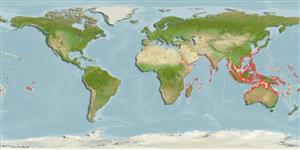Common names from other countries
Issue
The species in the genera Spratelloides Bleeker, 1851 and Jenkinsia Jordan & Evermann, 1896 should most probably be assigned to a separated family from Clupeidae and Dussumieriidae (Lavoué, pers. comm., July 2013). See a preliminary analysis in Lavoué et al. (2013: Ref. 93878).
Environment: milieu / climate zone / depth range / distribution range
Ecologie
marien; diepte ? - 40 m (Ref. 86942). Tropical; 33°N - 30°S, 33°E - 136°W (Ref. 188)
Indo-Pacific, from Red Sea south to Tanzania and east to Samoa (excluding the Cook, Society and Marquesas islands) and the Tuamoto Islands, north to southern Japan and south to western Australia and Kermadec Islands.
Lengte bij maturiteit / Grootte / Gewicht / Leeftijd
Maturity: Lm ?, range 4 - ? cm
Max length : 10.5 cm SL mannelijk / geslacht onbekend; (Ref. 54980)
Dorsale stekels (totaal) : 0; Dorsale zachte stralen (totaal) : 12 - 13; Anale stekels: 0; Anale zachte stralen: 12 - 13. Maxilla toothed, triangular pre-maxillae, 2 supra-maxillae, second supra-maxilla asymmetrical (lower part larger than upper part), vertical striae on scales not meeting at center; W-shaped pelvic scute; few branchiostegal rays (6 or 7).
Usually an inshore schooling species, inhabiting relatively clear waters of coastal, lagoon, and seaward reefs (Ref. 11230). Relative fecundity is 1596 eggs per unit body weight (Ref. 4383). Caught with beach seines, purse seines, ringnets and dipnets. Marketed fresh or dried-salted (Ref. 5213). Used as bait in the tuna fishery.
Whitehead, P.J.P., 1985. FAO Species Catalogue. Vol. 7. Clupeoid fishes of the world (suborder Clupeoidei). An annotated and illustrated catalogue of the herrings, sardines, pilchards, sprats, shads, anchovies and wolf-herrings. FAO Fish. Synop. 125(7/1):1-303. Rome: FAO. (Ref. 188)
Status op de Rode Lijst van het IUCN (Ref. 130435)
CITES (Ref. 128078)
Not Evaluated
Gevaar voor de mens
Harmless
Gebruik door de mens
Visserij: van minder commercieel belang; aas: usually
Tools
Speciale rapporten
Download XML
Internetbronnen
Estimates based on models
Fylogenetische diversiteitsindex (Ref.
82804): PD
50 = 0.5625 [Uniqueness, from 0.5 = low to 2.0 = high].
Bayesian length-weight: a=0.00513 (0.00321 - 0.00820), b=3.11 (2.97 - 3.25), in cm Total Length, based on LWR estimates for this species & (Sub)family-body (Ref.
93245).
Trofisch niveau (Ref.
69278): 3.1 ±0.0 se; based on diet studies.
Weerstandsvermogen (Ref.
120179): Hoog, minimale populatieverdubbelingstijd minder dan 15 maanden (K=0.41-0.44; tm<1; Fec=505).
Prior r = 1.19, 95% CL = 0.78 - 1.78, Based on 1 data-limited stock assessment.
Fishing Vulnerability (Ref.
59153): Low vulnerability (10 of 100).
Climate Vulnerability (Ref.
125649): High vulnerability (62 of 100).
